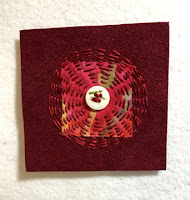Storm started out easy. The word was given some time back as
a 12X12 challenge at the EtCetera group I belong to. I had a lot of ideas to start out but I finally decided I wanted to do a
stormy looking landscape, but it took a while for me to get started. I’m not
sure why but it did.
Then I started.
Select fabrics from my stash.
Cut and fuse pieces to indicate stormy sky, hills, watery
grassy foreground.
I stitched down all
the pieces of fabric with my sewing machine.
Then it stalled.
I always like to hand stitch marks on my work; however, I
was afraid to start hand stitching for fear of messing it up. Which really was
too bad because I knew I could cover up any messes with more fabric.
Finally, I took a deep breath and started.
I knew I
wanted to add some birds to the scene on the bottom portion. I didn’t feel
confident in stitching birds there by hand and I really didn’t want them to stand
out from the piece.
And so I stalled again.
Then the light bulb came: what if I painted the birds on
with black paint and then just highlighted them with a few stitches?
I found a bird shape
I liked, took it into photoshop and made an outline, resized it, copied it
twice so I had 3 birds. Resized one so it was smaller and flipped another one
so that it faced the other 2 birds. After printing it out and checking the size
in relation to the full piece I was satisfied. I used an X-acto knife to cut
and make a stencil of the birds. I was nervous about stenciling right onto the
quilt. I used a scrap of the fabric to test the stencil. Then after using
acrylic black paint to paint the birds, I placed a piece of felt on the back so
I could test stitching some highlights on the birds.
Once I was done I held the scrap piece on the quilt. I liked
the way it looked with the felt backing and how that popped out. I still wanted
to do some hand stitching on the main piece.
Stalled again.
Finally, I picked up needle and thread, took a deep breath
and started.
The stitching is done, the binding applied, and the bird
piece glued on. But was it finished?
The binding had been pieced below the hills with fabric that
matched the bottom third of the quilt. I was bothered by the light marks on the
right-hand lower side. A little dark paint covered up the lower two light spots
and now I’m satisfied.
Another one checked off my FoF (Focus on Five) list!
Happy needle pulling thread!
Rose



















